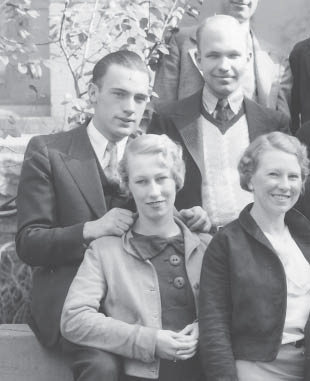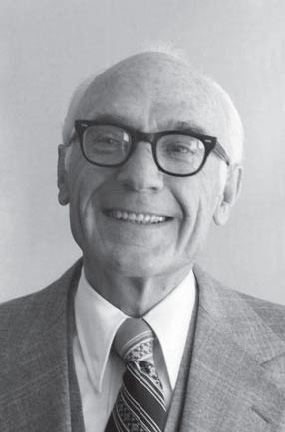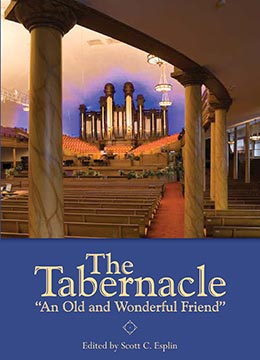Stewart L. Grow: Teacher and Tabernacle Historian
Scott C. Esplin, “Stewart L. Grow: Teacher and Tabernacle Historian,” in The Tabernacle: “An Old and Wonderful Friend” (Provo, UT: Religious Studies Center, Brigham Young University, 2007), 65–73
The life and mission of Professor Stewart L. Grow, author of the accompanying thesis on the Salt Lake Tabernacle, can be summarized in a poem he frequently cited:[1]
“Abou Ben Adhem”
By Leigh Hunt
Abou Ben Adhem (may his tribe increase!)
Awoke one night from a deep dream of peace,
And saw, within the moonlight in his room,
Making it rich, and like a lily in bloom,
An Angel writing in a book of gold:
Exceeding peace had made Ben Adhem bold,
And to the presence in the room he said,
“What writest thou?”—The vision rais’d its head,
And with a look made of all sweet accord
Answer’d, “The names of those who love the Lord.”
“And is mine one?” said Abou. “Nay, not so,”
Replied the Angel. Abou spoke more low,
But cheerily still; and said, “I pray thee then,
Write me as one who loves his fellow-men.”
The Angel wrote, and vanish’d. The next night
It came again with a great wakening light,
And show’d the names whom love of God had bless’d,
And lo! Ben Adhem’s name led all the rest.[2]
Like Abou Ben Adhem, Stewart L. Grow loved his fellowmen and served them well as a teacher, administrator, and mentor.
The Teacher, Administrator, and Mentor
Stewart Grow’s life prepared him to be a teacher. A native of Hillspring, Alberta, Canada, he was born on August 31, 1913, to Henry and Mary Emma Lofgreen Grow. Leaving Canada, he attended Brigham Young University, graduating in political science in 1935. Following graduation, he went to Washington DC, where he served as an assistant to Congressman J. W. Robinson of Utah and Senator John H. Overton of Louisiana. He also worked as an administrator in the U.S. Treasury Department, the War Production Board, and the Office of Price Administration during the late 1930s and early 1940s. During World War II, he served as an officer in the U.S. Army.
 Stewart L. Grow (far left) with other members of the first BYU Press Club, 1935.
Stewart L. Grow (far left) with other members of the first BYU Press Club, 1935.
Grow’s career path changed after marrying Sarah Mabey on July 31, 1941. Though they returned to Washington DC following their marriage, familial ties ultimately called them back to Utah. Returning to Provo, Grow earned a master’s degree in history from BYU in June 1948, writing a thesis on the history of the Salt Lake Tabernacle. In the meantime, BYU hired him as a special instructor teaching political science and history.
“Having decided to be a teacher, I knew it was now very important that I complete a PhD degree,” Grow noted.[3] He continued his studies at the University of Utah, completing a PhD in political science in 1954. His professor G. Homer Durham called his dissertation on politics in Utah in the late nineteenth century “one of the finest that they had received.”[4]
Returning to his full-time position at BYU, Grow gained prominence as a teacher and administrator. In 1956 he was selected to chair the university’s newly formed Political Science Department. Five years later, he likewise headed the Institute of Government Service, BYU’s first graduate program in public administration. In a university career marked by administrative assignments, Grow later served as acting dean of BYU’s graduate school.
Though founding and chairing programs became his staple, Grow was continually attracted to the classroom, where he influenced countless students as a mentor. Regarding his love of teaching, he later remarked, “Although I have enjoyed administration, consulting, etc., most of my pleasure and honors have come from teaching. Shortly after I started to teach, I fell in love with the profession and that love affair continues today.”[5] Interacting with students brought him particular happiness. He further observed, “Although I have enjoyed nearly all aspects of university life, the contacts in the classroom and with the students have been the most rewarding. As soon as I felt competent in my capacity to teach, I think was able to develop good rapport with my students. I have looked on them as friends rather than just as students, and they have reciprocated. In a way, I have regarded them as an extension of my family and have had, and still have, many rewarding experiences in my relationships with them.”[6]
Students sensed Grow’s commitment to teaching and resonated with it. In 1959 the student body selected him and Dr. Reed Bradford as the first professors of the year.[7] In May 1970 the university awarded him the Karl G. Maeser Distinguished Teaching Award, the campus’s highest teaching award. Later that year he was also granted the title of distinguished professor, only the fourth to have held the title at BYU. The Alumni Association later bestowed their distinguished service award on him.
Though academic life occupied much of his time, Grow carefully watched his priorities. “Throughout our married lives,” he later remarked, “Sarah and I, without being too rigid about it, have attempted to lead a balanced life which has included work, social and Church activity, and participation in travel and public service activities.”[8] Raising six children, he served as bishop and high councilor at a BYU ward and later as patriarch of the BYU First Stake. His wife, Sarah, frequently served in music and Relief Society callings, including serving as a member of the Church’s General Relief Society Board for seven and a half years.
During his thirty-two years of teaching, Grow made numerous contributions to campus life. However, his most prominent legacy can still be seen at the west entrance to BYU, where his slogan, “Enter to Learn, Go Forth to Serve,” has welcomed people to campus since 1965. Of the motto, Grow reminisced, “Perhaps ‘Enter to Learn, Go Forth to Serve’ is a distillation of my life’s philosophy. We are born to gain experience in learning and have both the obligation and the reward of serving. The world has existed constantly in turmoil, war, and other troubles. Even so, man has survived and found pleasure in living. I know of no better way to expand the joy which man should have than to create a world in which all men will be motivated to learn and to serve each other.”[9]
Summarizing his life’s experiences, Grow wrote, “If the members of my family, or my students, can find a profession that rewards them as well as teaching at BYU has rewarded me, then they will have found a pearl of great price.”[10] Others observed that association with Grow himself was a pearl of great price. Then dean of the BYU Law School, Rex Lee wrote of Grow, “From having discussed the matter with some of my contemporaries, I would conclude that he has probably had a greater influence on Mormon lawyers who have entered the profession within the last 30 years than any other human being. This is especially remarkable in light of the fact that he is not a lawyer.”[11] At a banquet honoring Grow’s accomplishments, BYU President Dallin H. Oaks told Grow, “There is no way I can adequately express my gratitude for your influence on my as a student at BYU, as a student at the University of Chicago Law School, and as a young lawyer. I cannot even give illustrations. Your influence was too fundamental, too intertwined with the roots of my basic orientation, aspirations, and self-confidence. You had a unique influence. You persuaded me to set my sights ever higher and higher. I always felt your interest and confidence in me and your loving expectation that I would do the best of which I was capable. That was the measure of your influence on my life. And for that I will ever be grateful.”[12]
 Stewart L. Grow
Stewart L. Grow
Shortly after his retirement, Stewart L. Grow was diagnosed with cancer, from which he died on April 17, 1983. At his funeral, then Utah Supreme Court Justice Dallin H. Oaks summarized the influence of Stewart Grow: “His boys, as he called them, his boys will continue to have influence on the nation and on the Church and on communities across the length and breadth of the land. As they do so, they will remember Stewart and bless his name and extend his influence to generations unborn. May God bless his memory.”[13] Following Grow’s death, a grateful student penned the following letter to the editor of the Deseret News summarizing Grow’s contributions:
To the editor:
Each of us has been reared in part through the influence of teachers. Some teachers are forgotten, some teachers are remembered only on occasion, and some teachers—a very few—are loved and cherished forever.
Dr. Stewart L. Grow, professor of political science at BYU, touched thousands of lives as a teacher and made each of us his friend. There are hundreds of attorneys in practice today who point to him as a special influence in directing them into the profession of law.
Dr. Grow’s death on April 17 brings sorrow of the moment. But we as his students remember that we sat at the feet of a great character builder. He taught us that we could chart our own destiny and then, behind the scenes, unpretentiously, he helped us achieve that goal.[14]
The Tabernacle Thesis
His 1948 thesis, “A Historical Study of the Construction of the Salt Lake Tabernacle,” reflects only a small portion of the accomplishments of Stewart L. Grow. However, like his influence on the students whose lives he touched, the work continues to impact scholarship after his death.
In his own words, Grow settled on the topic because of his surprise that “only a small amount of writing had been done on the subject of the Tabernacle and this was restricted primarily to short newspaper articles.”[15] His experience also led him to believe there was “a wide-spread interest in having a history of the construction of the Tabernacle.”[16] For Grow, the topic was especially appropriate, since he was the great-grandson of Tabernacle architect Henry Grow. Noting the relationship in the foreword, he sought to “be careful in assessing the part played by Mr. Grow in the construction of the Tabernacle and to minimize the effect of family pride.”[17] Largely succeeding in his efforts, the work portrays a balanced view regarding those responsible for the Tabernacle’s construction, properly crediting not only Henry Grow but also Brigham Young, William Folsom, and Truman Angell as architects.
Following completion of his thesis, Grow rewrote the work for later publication. The volume emerged as a book entitled A Tabernacle in the Desert, published by Deseret Book Company in 1958. For decades, this volume and the thesis that preceded it remained the preeminent works on the history of the construction of the Salt Lake Tabernacle. Additionally, Grow himself continued to write on the subject.[18]
This edited version of Grow’s thesis provides those interested in the Salt Lake Tabernacle with access to its classic history. It is reproduced in its entirety with some editorial changes. These include corrections to miscopied sources and occasional standardization of spelling and grammar, capitalization, and punctuation to enhance readability. Originally written in an era when electronic reproductions of sources were limited, Grow generally succeeded in painstakingly transcribing the record. This included the most problematic of the sources, Truman Angell’s journals, which lack standardized spelling and punctuation. These and all other sources have been thoroughly checked and, where necessary, modernized for clarity. However, to preserve Angell’s unique voice, the colloquial grammar has been preserved. Additionally, minor corrections have been made to apparent mistakes in the document. In all of these improvements, special appreciation is expressed to Beth Sutton and Beth Hixson, employees of BYU’s Religious Studies Center, who painstakingly checked, updated, and corrected every source in the thesis. Without their help, this project would have been impossible. The editor hopes these corrections are truly improvements to help a modern audience appreciate the important historical contribution of Stewart Grow’s thesis and rejoice in the legacy of the Salt Lake Tabernacle.
Notes
[1] Stewart L. Grow, My Autobiography, L. Tom Perry Special Collections, Harold B. Lee Library, Brigham Young University, Provo, UT, 163.
[2] Leigh Hunt, The Poetical Works of Leigh Hunt and Thomas Hood, ed. J. Hardwood Panting (London: Walter Scott, 1889), 53–54.
[3] Stewart L. Grow, My Autobiography, Special Collections, Harold B. Lee Library, BYU, 76.
[4] Grow, My Autobiography, 78.
[5] Grow, My Autobiography, 118.
[6] Grow, My Autobiography, 81.
[7] Grow, My Autobiography, 120.
[8] Grow, My Autobiography, 123.
[9] Grow, My Autobiography, 129.
[10] Grow, My Autobiography, 122–23.
[11] Grow, My Autobiography, 122.
[12] Grow, My Autobiography, 156.
[13] Grow, My Autobiography.
[14] M. Byron Fisher, “A Cherished Y Teacher,” Deseret News, April 26, 1983, A4.
[15] Stewart L. Grow, “A Historical Study of the Construction of the Salt Lake Tabernacle” (master’s thesis, Brigham Young University, 1947), iii.
[16] Grow, “A Historical Study of the Construction of the Salt Lake Tabernacle,” iii.
[17] Grow, “A Historical Study of the Construction of the Salt Lake Tabernacle,” v.
[18] See Stewart L. Grow, “The Building of the Tabernacle,” Improvement Era, April 1967, 4–9.
